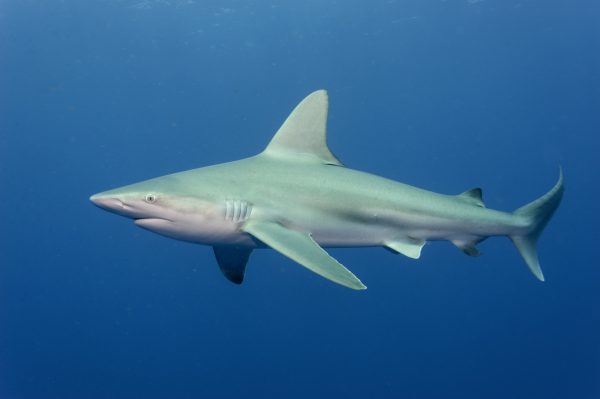
Florida Museum photo by Kristen Grace
Before the summer of 1916, there was still debate about whether sharks could kill humans.
Most people were not even sure if a shark could bite a human. One of them was New York multimillionaire Hermann Oelrichs, who offered a $500 reward in 1891 for anyone who proved a shark attacked a human. That prize would be worth nearly $13,000 today.
But this July marks the 100th anniversary of events that ended the debate.
From July 1-12, 1916, dubbed the “Twelve Days of Terror,” four people died and another was wounded in five New Jersey shark attacks. The attacks garnered national media attention and sparked a newfound fear of sharks.
In an East Coast-centric society highly focused on New York, Philadelphia, Boston and Washington D.C., the Jersey Shore’s convenient location was a vacation hotspot for the wealthy. Politicians, including President Woodrow Wilson, enjoyed summer getaways there. And during a polio epidemic and sweltering heat wave in 1916, thousands flocked to the seaside paradise.
But people started to panic after news headlines suggested an aggressive shark lurked in the water along the shoreline.
“It literally landed on the desk of the president,” said George Burgess, who directs the Florida Program for Shark Research and International Shark Attack File based at the Florida Museum of Natural History on the University of Florida campus. “It was affecting everybody.”
The attacks occurred sequentially from south to north in a pattern suggesting a single animal was responsible.
“The original bites were occurring along the New Jersey coastline,” Burgess said. “At least one newspaper attributed it to sea turtles, which of course nothing could be further from the truth. That’s how adamant they were that it couldn’t be sharks.”
After attacking the first two victims, the shark swam north to Sandy Hook, New Jersey, and made its way into Matawan Creek. Once it realized the depth of the creek would become more shallow, Burgess said, the shark turned around to head back into the sea. That’s when the other three attacks occurred.
Because the attacks took place in a creek, some experts suspected a bull shark, because it’s the only shark that regularly swims into fresh or brackish water.
But this was not an ordinary creek.
“It’s anything but a stream,” Burgess said. “It’s a large tidal creek, and as it turns out the attacks occurred on a high tide on a full moon, which meant the tide was as high as it could be and it had maximum salinity.”
This information, along with the severity of the human injuries and the fact that a great white shark was later caught with human remains in its stomach, led Burgess to believe it wasn’t a bull shark.
He thinks it was a great white.
“Jaws” and the beginning of a global nightmare for sharks
Two musical notes, an E followed by an F, spiked viewers’ heart rates as they watched carefree swimmers fall victim to a 25-foot-long, revenge-seeking great white shark with an insatiable appetite for human flesh in “Jaws.”
The 1975 film, based on Peter Benchley’s 1974 novel of the same name, ignited a fear in people that eclipsed the 1916 attacks. While the novel was based partially on the New Jersey events, the movie producers exercised extreme artistic license.
Viewers’ anxiety of sharks was not limited to screams in a theater. It gave them ideas.
“When the movie came out, there was a collective testosterone rush that went up and down the East Coast of the United States,” Burgess said.
Fishermen wanted to prove how brave they were, and with the ease of either taking a small boat onto the water or simply fishing from shore, catching sharks as large as 500 pounds was possible with a reasonable size rod and reel.
In addition to people fishing on their own, Burgess said, sponsored fishing tournaments began that initiated organized shark fishing for prizes.
But this was only the start.
In the late 1980s, commercial fishing for swordfish increased, which Burgess said also resulted in more shark catches. When the swordfishery collapsed, fishermen decided to market the sharks, and the shark-fin trade skyrocketed.
Some fishers engaged in the wasteful practice of shark finning–catching sharks and slicing off their fins to sell, while leaving the rest of their bodies in the ocean. The sharks are typically left alive but sink to the bottom of the sea and die because they cannot swim.
Because of booming economies in eastern Asia, people could now afford the delicacy of shark fin soup, so demand also increased.
“The markets for shark fins opened up at an international level,” Burgess said. “It was one of the most lucrative items of the sea. You can get it anywhere from $20 to $30 a pound, and they don’t have to be kept cold or frozen. You just throw them on the side of the deck because they’re going to be dried and sent to Asia.”
The steady drop in shark numbers presented a long-term problem, Burgess said. Sharks have “biological Achilles’ heels” in the sense that they’re slow-growing, reach sexual maturity at a late age, carry their young and only give birth every two to three years. These factors combined mean population declines could require decades to bounce back.
“The beginning of the end was ‘Jaws,’” Burgess said. “The end of the end was commercial fishing.”
Perception, education and regression
Big, open jaws.
To Burgess, that’s what most people think of when they hear the word “shark.”
Since the early 1900s, more than 70 movies have been made about killer sharks, and they continue to hit theaters and television screens today.
News media jump at the chance to create teasing headlines or broadcasts that tell consumers about shark-infested waters or man-eating sharks whenever an attack is reported.
“They’re not ‘shark-infested’ waters,” Burgess said. “They’re ‘shark-inhabited’ waters. If there is infestation, it’s by us.”
Despite the unfavorable attitude about sharks, Burgess thinks the world has become more educated and sympathetic toward sharks.
“But it’s a fragile truce,” he said.
After a high-profile attack, such as the eight attacks in 2015 off the coast of North Carolina, people tend to remember “Jaws” and regress to the fear instilled by the movie.

Photo by David B. Snyder
Even though a person has about a one in 3.7 million chance of being killed by a shark, and a far better chance of being killed in a car accident, by lightning or even sand holes on the beach, the terror of sharks remains a focal point in entertainment and media.
“The fact of the matter is that nobody wants to be eaten by something else,” Burgess said. “It may be the grown-up equivalent of the monster under the bed.”
Burgess acknowledges sharks are considered “charismatic megafauna,” like lions and tigers, and fascinate people. Because sharks are highly visible apex predators, they receive much attention.
He said it’s ironic from a conservation standpoint that sharks, regarded as ferocious carnivores of the sea, are also one of the most vulnerable. And if their populations rapidly decline, it means trouble in the water.
There are more than 400 species of sharks, which play a crucial role in ocean biodiversity and ecosystems because of their place in the food web. Because sharks feed on sick and dying as well as healthy animals, losing them causes an imbalance.
“In many ways sharks are poster children for the declining health of the sea,” Burgess said, commenting on overfishing, habitat alteration and ocean pollution.
100 years of shark-human encounters
2015 saw the highest number of shark attacks worldwide—98—and six were fatal.
Burgess partially attributes the rise in attacks to global warming, which has increased water temperatures and enticed more people to enter the water. Even more important is a continuously rising human population.
“The number of attacks is intimately connected to the population numbers of humans,” Burgess said. “We dictate how many attacks occur by how many of us go in.”
Over the past century, the overall trend shows an increase in reported unprovoked attacks each decade.
The number of attacks gradually increased during the early- and mid-20th century, with a sharp increase in the 1990s.
But judging by numbers, humans are the deadlier predators.
Saving the sharks: Think globally, act locally
Humans kill an estimated 30 million to 70 million sharks each year. Burgess said that may be a conservative estimate, with possibly 100 million killed annually.
Sharks are highly migratory and most tend to roam, which makes enacting laws to protect them somewhat difficult.
“Sharks don’t honor geopolitical borders,” Burgess said. “We’re talking about a worldwide problem.”
The way to help conserve sharks, Burgess said, is to “think globally and act locally.”
The Florida Program for Shark Research works throughout the state and nation, but also collaborates with international organizations such as the International Commission for the Conservation of Atlantic Tunas and the International Union for Conservation of Nature.
Program researchers also travel to developing nations to educate other scientists about conservation efforts and best practices.
“To me, that’s the most important thing we do,” Burgess said.
But what can ordinary people do to help save the sharks?
The biggest problem is the negative perception of sharks, Burgess said. People can help change that perception by speaking truthfully about sharks and not contributing to the misconceptions or stereotypes promoted in mainstream media and entertainment.
“You can also work collaboratively with conservation or academic groups and programs,” Burgess said. “We can help you understand where the next battles are.”
If people can work collectively to fight those battles and change the public perception of sharks, positive change can happen, he said. The popular view of sharks would steer away from the “Jaws” image and more toward what Burgess thinks when he hears the word “shark”:
A threatened predator that needs our help to survive.
George Burgess has directed the Florida Program for Shark Research and International Shark Attack File at the Florida Museum of Natural History for three decades. He is one of the University of Florida’s most quoted media sources, and considered an expert on shark ecology, conservation and attacks. He is the author of “Sharks – The Animal Answer Guide,” published in 2014, and “Marine Fishes of Florida,” to be released later this month.
Learn more about the Ichthyology Collection at the Florida Museum.